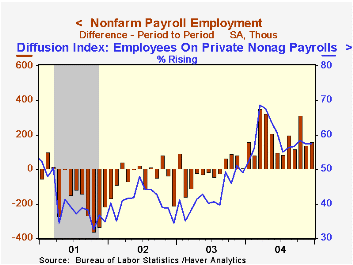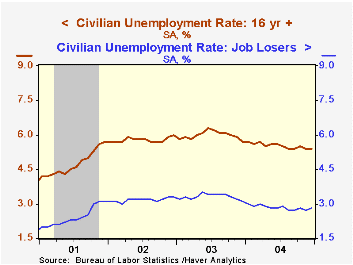 Global| Jan 07 2005
Global| Jan 07 2005Scattered Industry Gains Lift U.S. Employment Again
by:Tom Moeller
|in:Economy in Brief
Summary
Non-farm payrolls in December rose 157,000 following an upwardly revised gain of 137,000 in November. Consensus expectations had been for a 175,000 December increase. Payrolls have risen in each month since September of 2003 and the [...]

Non-farm payrolls in December rose 157,000 following an upwardly revised gain of 137,000 in November. Consensus expectations had been for a 175,000 December increase. Payrolls have risen in each month since September of 2003 and the average monthly gain during that period was 155,000.
Hiring was strongest last month in selected private service producing industries, up 115,000 (2.0% y/y). Jobs in the financial sector rose 14,000 m/m (1.8% y/y) and professional & business services rose 41,000 (3.4% y/y). Jobs in education & health rose 47,000 (2.4% y/y) and wholesale trade jobs rose 17,000 (1.7% y/y). Gains elsewhere were scattered as indicated by the one month diffusion index for private payrolls of 57.6. While improved from the 2003 figure of 42.9%, this breadth of job gain figure will range between 65 and 70 when the labor market is strongest.
Factory sector payrolls rose modestly for the first gain in four months and the one month diffusion index of job gain at 51.2 crept above the break even line of 50 for the first time since July.
Government employment rose 29,000 (0.8% y/y). Federal government jobs fell 7,000 (-0.5% y/y) but that was offset by increased state (+1.0% y/y) and local (+1.0% y/y) hiring.
The index of aggregate hours worked (employment times hours worked) rose 0.4% (+2.9% y/y) in December and the index rose at a 2.1% annual rate in the fourth quarter, down from 3.1% in 3Q.
Average hourly earnings rose the same 0.1% (2.7% y/y) as in November. In the service sector, small 2.3% y/y gains in the financial and in the professional & business service industries were offset by a strong 3.8% gain in information services. Manufacturing earnings rose 2.7% last year.
Revised figures from the separate household survey indicate that the unemployment rate held steady at 5.4%. Employment fell 137,000 (+1.3% y/y) but the labor force also fell by 110,000 (1.0% y/y). The labor force participation rate dipped slightly to 66.0% and that was the average for 2004 versus 66.2% in 2003 and 66.6% in 2002.
Today's comments from Federal Reserve Board Governor Ben S. Bernanke on "The Transition from Academic to Policy Maker" can be found here.
"Do Actions Speak Louder Than Words? The Response of Asset Prices to Monetary Policy Actions and Statements" is a Working Paper from the Federal Reserve Board and it is available here.
| Employment | Dec | Nov | Y/Y | 2004 | 2003 | 2002 |
|---|---|---|---|---|---|---|
| Payroll Employment | 157,000 | 137,000 | 1.7% | 1.0% | -0.3% | -1.1% |
| Manufacturing | 3,000 | -9,000 | 0.5% | -1.0% | -4.8% | -7.2% |
| Average Weekly Hours | 33.8 | 33.7 | 33.6 | 33.8 | 33.7 | 33.8 |
| Average Hourly Earnings | 0.1% | 0.1% | 2.7% | 2.7% | 2.7% | 2.9% |
| Unemployment Rate | 5.4% | 5.4% | 5.7% | 5.5% | 6.0% | 5.8% |
Tom Moeller
AuthorMore in Author Profile »Prior to joining Haver Analytics in 2000, Mr. Moeller worked as the Economist at Chancellor Capital Management from 1985 to 1999. There, he developed comprehensive economic forecasts and interpreted economic data for equity and fixed income portfolio managers. Also at Chancellor, Mr. Moeller worked as an equity analyst and was responsible for researching and rating companies in the economically sensitive automobile and housing industries for investment in Chancellor’s equity portfolio. Prior to joining Chancellor, Mr. Moeller was an Economist at Citibank from 1979 to 1984. He also analyzed pricing behavior in the metals industry for the Council on Wage and Price Stability in Washington, D.C. In 1999, Mr. Moeller received the award for most accurate forecast from the Forecasters' Club of New York. From 1990 to 1992 he was President of the New York Association for Business Economists. Mr. Moeller earned an M.B.A. in Finance from Fordham University, where he graduated in 1987. He holds a Bachelor of Arts in Economics from George Washington University.






